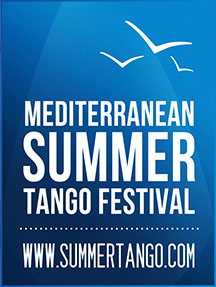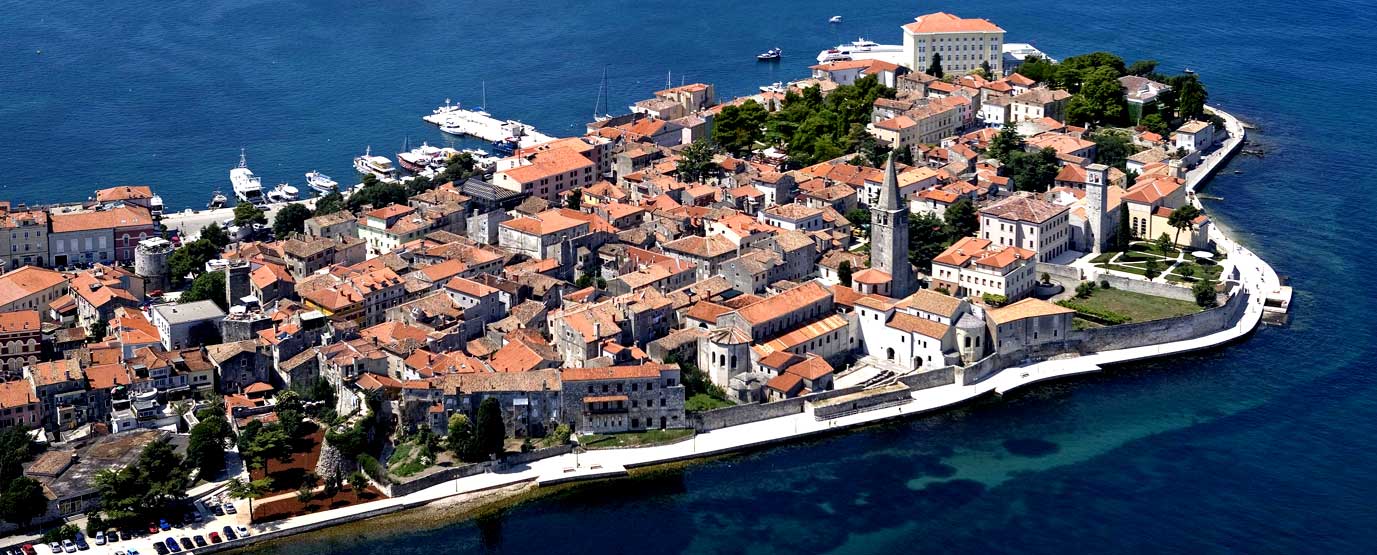
City of Poreč
The center of Poreč is gorgeous. Taking a stroll through it is something you don’t want to miss – especially if you are visiting the city for the first time. In this former Roman colony you can enjoy the sights of Romanesque architecture with beautiful Venetian gothic palaces that will make your walk a truly memorable experience. Its orthogonal set of streets has been completely preserved till today! During the reign of the Byzantine emperor Justinian, Poreč reached its highest peak. This will become obvious to you once you see the Euphrasius’ basilica, beyond doubt a breathtaking sight. It was built in the middle of the 6th century in the Byzantine style, and the mosaics on its front and interior are truly one of the most beautiful works of art in the world! The whole edifice has been included in the UNESCO’s World Heritage list. Entering the basilica, you will feel the ghosts of past centuries and will be able to touch the eternity!
We recommend a visit to the medieval Romanesque house with an interesting wooden balcony. The gothic pentagonal tower once served as the town gate, and now it is the entrance to an exceptional world of new all-evening gastronomic discoveries.
When the sun rises again, take pleasure in wonderful beaches, where the land touches the sea under the green cloak of coniferous trees.
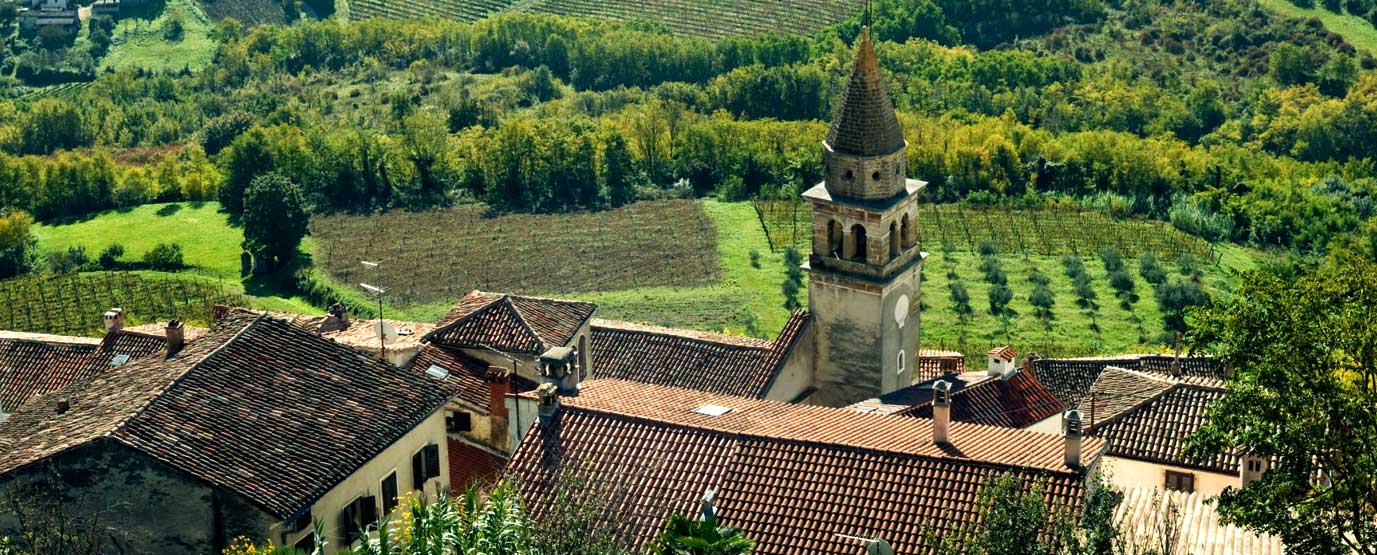
Istrian Region
Second name for istrian countryside is ‘Croatian Tuscany’, for a very good reason. The dreamlike nature, almost mythical landscapes and gorgeous medieval towns of central Istria will awake within you the primeval and deep, true pleasure!
Central Istria is one of the rare Mediterranean regions adorned with the quality of unspoiled natural landscapes and rich heritage. Numerous coves and hillocks connect and divide many magic-like settlements, creating almost unreal scenery.
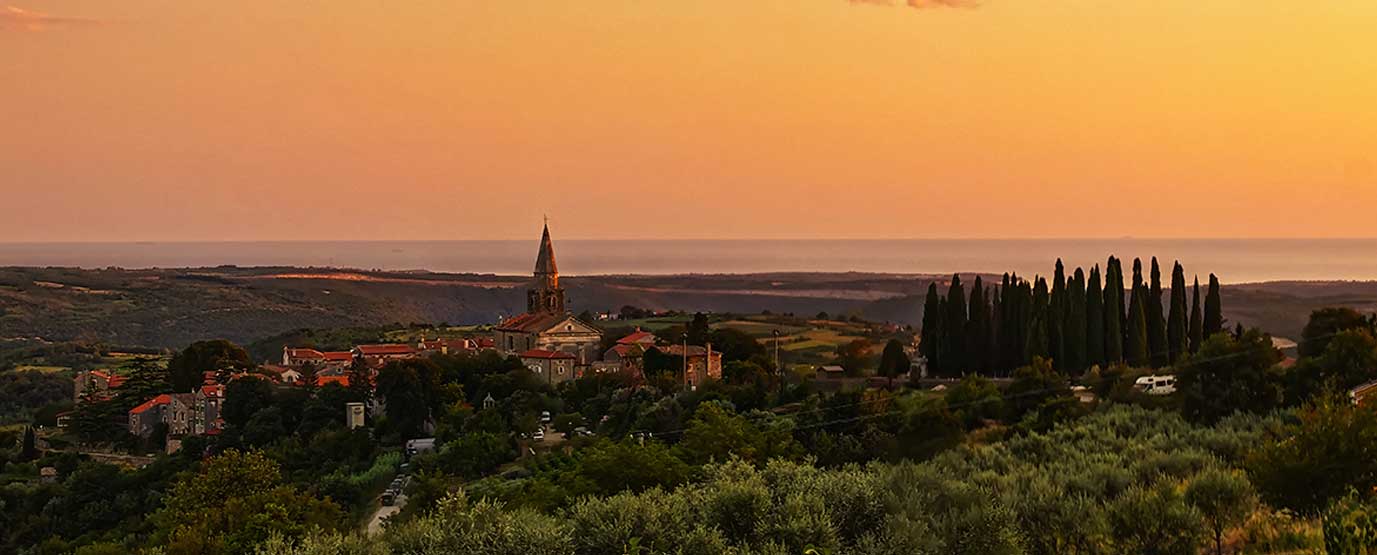
Grožnjan
Grisignana – cca 35km from Poreč
Grožnjan, a small Istrian town of great cultural significance not only in Croatia but also internationally, lives its summer months very intensely. Every year at the beginning of May, the little streets and squares of Grožnjan metamorph and turn into a truly artistic beehive: it opens its summer music academies for young people, its artistic, dance and drama workshops and its peace activism workshops under the leadership of well-known experts and teachers and famous names from music, art and drama.
During those few summer months Grožnjan lives and breathes art and the labyrinth of its little streets becomes one great stage on which are constantly interchanging the sounds of jazz and classical music, guitar and piano, violin and cello, drum and vibraphone. Perfect for artists and daydreamers.
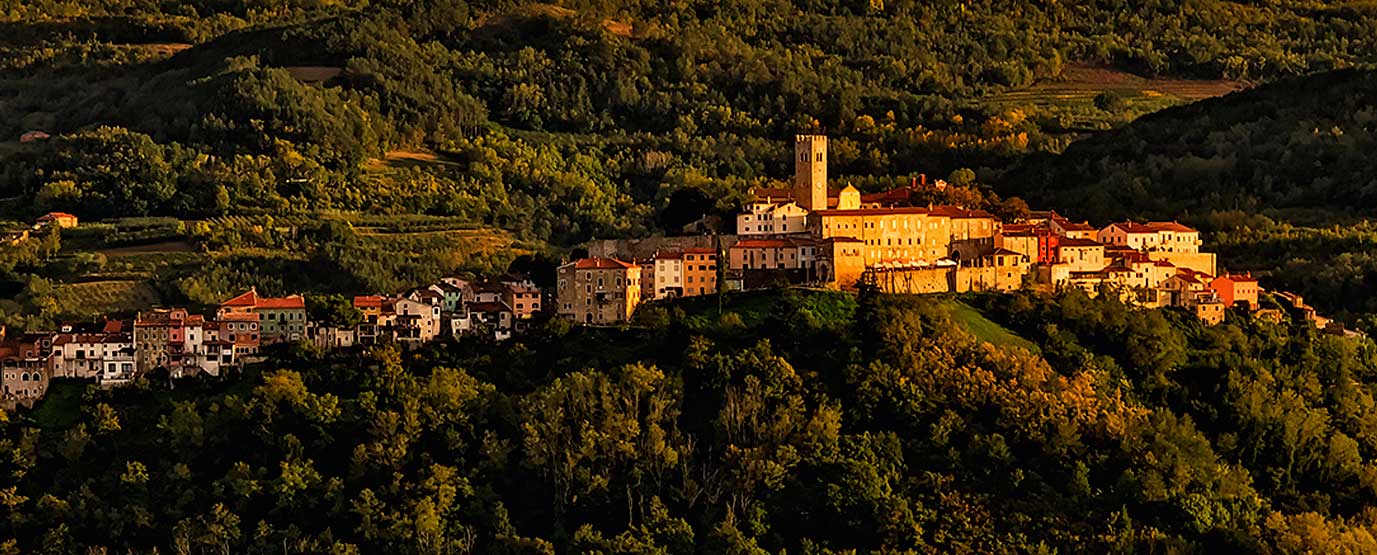
Motovun
cca 30km from Poreč
In the northern part of Istria, overlooking the Mirna River valley, lies surely the most famous and attractive Istrian medieval town of Motovun. This captivating hilltop town is one of the characteristic symbols of the Istrian interior. Motovun is the perfect venue for a large number of events, the most significant among them being the International Motovun Film Festival that takes place at the end of July where world-known film artists may be seen. Motovun is also interesting for ballooning lovers, its favourable microclimate enables flying in balloons all year round, so that Motovun hosts several ballooning events.
Opposite Motovun stands the charming picturesque town of Oprtalj, as well as Livade, famous for the Days of Truffles held every year from September to November. Every year in Livade, also known as the World’s truffle centre, a special festival is organized with a contest of choosing the largest truffle.Motovun is surrounded by vineyards from which the finest Istrian wines, white wine Malvasia and red wine Teran, are produced. The entire area is dotted with excellent local ‘konobe’ and restaurants. Perfect for gastro-movie-baloon flying lovers.
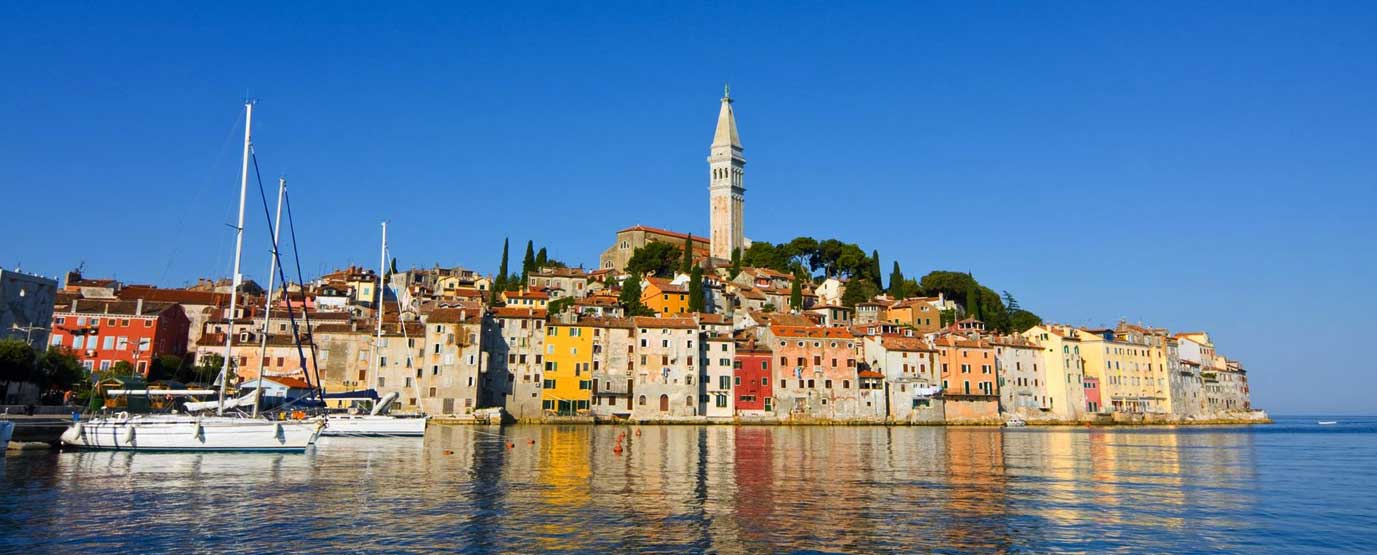
Rovinj
cca 35km from Poreč
Those of you who won’t be participating on our Boat Trip (are there any of those? – Ed) and would rather choose visiting the city by car alone or with smaller group of people here are some facts about this really amazing and extremely romantic city, has very strong power to seduce every random visitor with its beautiful cobblestoned streets, stone houses with all colored windows and hundreds of small arts galleries. One of the most ‘photogenic’ towns in the Mediterranean, once a fishing town, today is a tourist resort. At a distance of some 40 kilometres from Pula, Rovinj has long been known as the town with a favorable and beneficial climate. So, today its people are still proud of this long tradition and ‘fight’ for the title of ‘healthy town’… The rest is nature’s work.
The entire coastline, with its twenty-two islands is an area of protected natural heritage. Feel the enchantment of the town in its narrow medieval streets and warm Mediterranean setting. The main Church of St. Euphemia keeps relics of the saint and presents one of the most beautiful Baroque achievements in Istria. From the church plateau there is a wonderful view of the open sea and numerous islets in the distance. A visit to the Rovinj Town Museum and the town’s many galleries will complete your cultural experience.
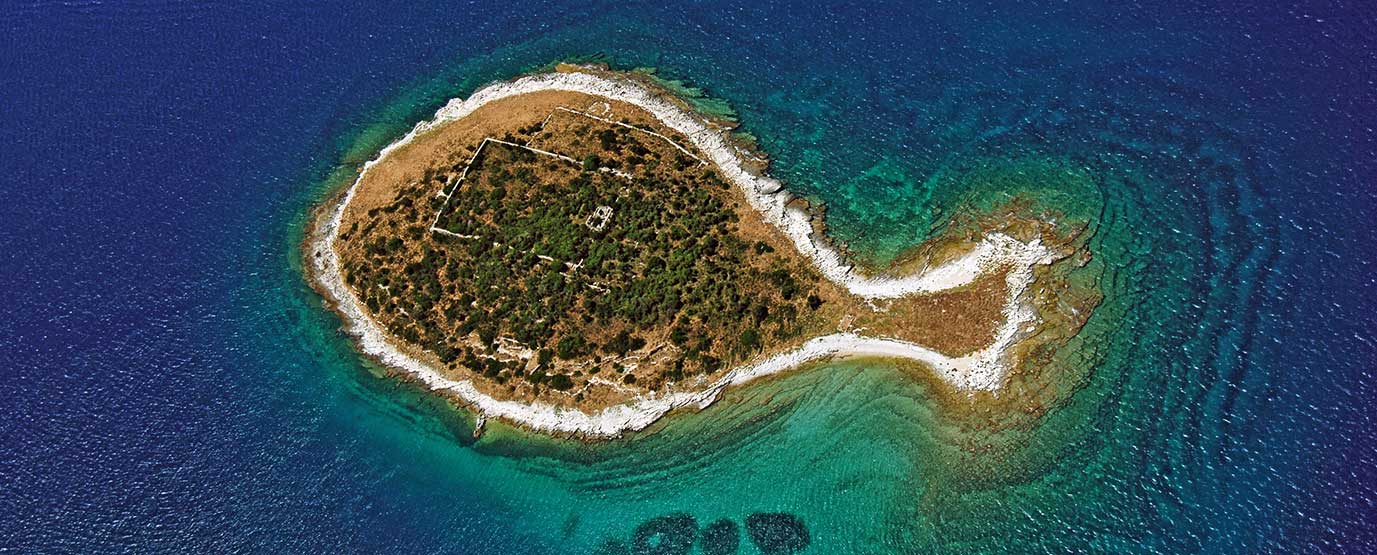
National park Brijuni
cca 50km from Poreč
The Maker intended to shape a part of the Earth to the image of Heaven. That is how Istria came into being, like a garden covered with magnificent trees and vast meadows, washed by the deep blue sea, appealing people to a happier life. But the jealous devil destroyed his work by tearing the bag in which the angel was carrying the unused stones. Thousands of rocks scattered around the Istrian land making it a land of contrasts, gentle and rough, fertile and barren, sunny and cloudy. The desolated angels gathered the pieces of Heaven remaining among the scattered rocks and protected them by the sea waves and created Brijuni.The Brijuni islands, found along the southwestern coast of Istria, were proclaimed a national park in 1983. They cover an area of 2,700 acres, and total fourteen larger and small islands, of which the largest are Veliki and Mali Brijuni.
Brijuni National Park is an oasis of the magnificent harmony between man, animal and plant life. There are almost 700 plant species and about 250 bird species on the islands, whereas the mild Mediterranean climate makes it a pleasant health resort. Day by day the long forgotten splendour of the past from the beginning of the 20th century is slowly returning to Brijuni which is once again becoming the elite meeting place of the business world. Each guest knows that on this small, yet unique area there is a chance to enjoy the simple and often forgotten charms of nature – clean air, crystal-clear sea and untouched Mediterranean vegetation. The islands can be reached by boat departing daily from the nearby fishing village of Fažana. Registration at the reception of the Brijuni National Park is required.
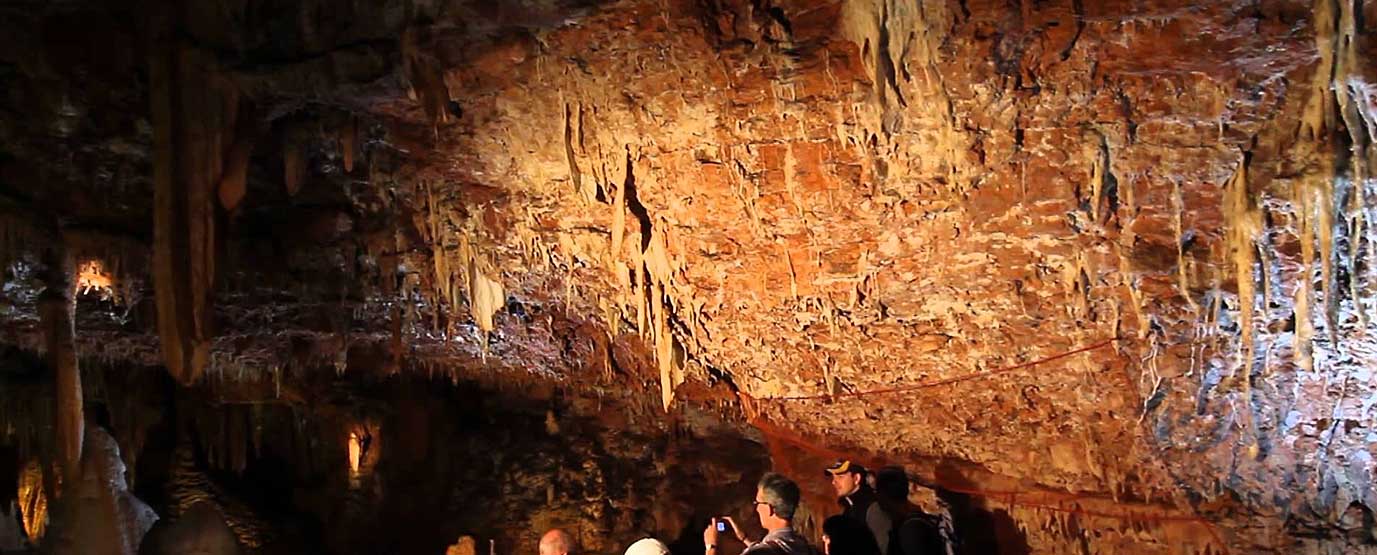
The Baredine Cave
Meet the mystical world of nature which has been developing for thousands of years, far away from the light of the day and the human eye. Visit the underworld the Baredine Cave. This cave is a treasure chest of stalagmites and stalactites, underworld sculptures created through time by the patient work of water. Such shapes have been created, some of which are exceptional, such as the 10 meter long and high curtains, a very realistic sculpture of Our Lady, the body of a milkmaid called Milka, the leaning tower of Pisa and snowman the torchbearer-who has become the trade mark of our cave. In one of the atriums you will pass a crater that is 4m wide and 66 m deep which goes down to the underground lakes.
And so through five halls, five galleries of abstract and realistic sculptures, a pleasant 40 minute walk, accompanied by a guide and custodian. The excitement of this adventure is also meeting the animals of the underworld. You will see the “human fish”, an endemic animal that lives only in this environment. At the cave’s entrance there is a museum showcase where pottery of prehistoric man has been exhibited. Our far ancestors would probably leave the pots during the hot, dry, summer day to collect the precious water, drop by drop.
